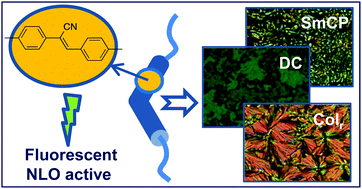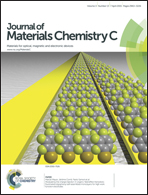Cyanostilbene bent-core molecules: a route to functional materials†
Abstract
The synthesis and characterization of novel compounds, that incorporate the high current interest functional cyanostilbene unit, are reported. Four examples, derived from 3,4′-biphenylene, have a 2D molecular-shape that promotes a variety of bent-core liquid crystalline phases (columnar, polar smectic C, and dark-conglomerate phases). The mesomorphism has been characterized by optical microscopy, differential scanning calorimetry, X-ray diffraction, and by detailed electrooptic and dielectric studies. The liquid crystalline properties can be modulated depending on the position of the cyano group on the C![[double bond, length as m-dash]](https://www.rsc.org/images/entities/char_e001.gif) C bond (α- or β-isomers) and the number of cyanostilbene units in the molecule (one or two). The polar smectic C mesophases have an antiferroelectric ground state. Furthermore, the multiresponsive nature of the cyanostilbene structure has led to very attractive and diverse photoactivity, including luminescence and second harmonic generation. The results obtained broaden the possibilities for the use of bent-core liquid crystals to design novel multiresponsive soft materials.
C bond (α- or β-isomers) and the number of cyanostilbene units in the molecule (one or two). The polar smectic C mesophases have an antiferroelectric ground state. Furthermore, the multiresponsive nature of the cyanostilbene structure has led to very attractive and diverse photoactivity, including luminescence and second harmonic generation. The results obtained broaden the possibilities for the use of bent-core liquid crystals to design novel multiresponsive soft materials.


 Please wait while we load your content...
Please wait while we load your content...